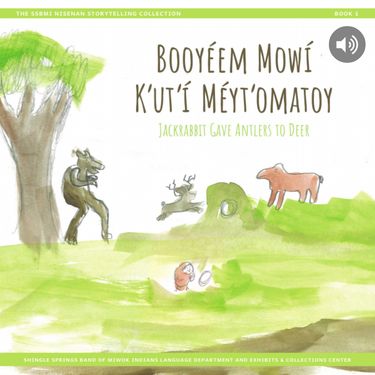Hesíbe hedém beeteyím? (What is this story?)
Like many other traditional stories, Booyéem Mowí K’ut’í Méyt’omatoy explains how some of the animals that we can see in the natural world today gained prominent physical characteristics during Creation Time. In particular, in this story we learn how K’ut’ (Deer) got his antlers: Booyée (Jackrabbit), who had his own antlers in those days, grew tired of getting them caught in the brush all the time. After almost being caught and eaten by Olé (Coyote), he gave his antlers to K’ut’ who continues to wear them to this day.
This story was originally told by Bill Joe, a Nisenan man from Amador County and the uncle of Acorn Jack; Acorn Jack was the first husband of SSBMI Matriarch Annie Hill Murray Paris and the father of her daughter Carrie Charlton, linking Bill Joe to the SSBMI Tribal Membership. Bill Joe originally told this story in Nisenan and English to Danish linguist Hans J. Uldall in the 1930s. It was later published under the title "Rabbit Gives Horns to Deer" in the book Nisenan Texts and Dictionary in 1966, together with 70 other stories that Bill Joe shared. In repackaging this story for the SSBMI Nisenan Storytelling Collection, the Language Department retitled it in Nisenan as "Booyéem Mowí K’ut’í Méyt’omatoy" (Jackrabbit Gave Antlers to Deer), in a way that we feel Bill Joe himself might have titled the story.
As you read or listen to the story, you may notice that many of the Nisenan words end in -t’omatoy. This is an important set of grammatical markers which Bill Joe uses to indicate that the events he describes took place in the past. Moreover, they indicate that Bill Joe did not witness these events himself; rather, he learned about them from others. Whether you choose to read this story in Nisenan or in English, by sharing this story with others you are participating in Indigenous traditions of teaching and sharing knowledge through oral storytelling. You are actively participating in the revitalization and continuation of language and culture. Wenném! (Thank you!)
Webpage last updated: 2025-05-06
 Jackrabbit Gave Antlers to Deer
Jackrabbit Gave Antlers to Deer









































